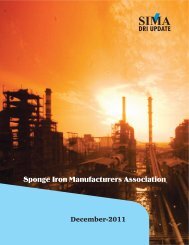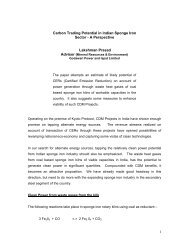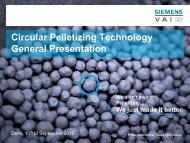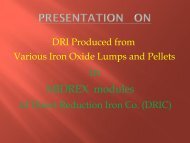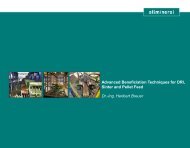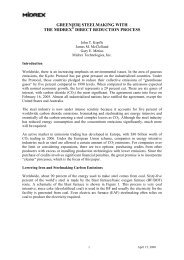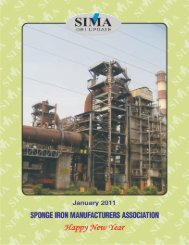You also want an ePaper? Increase the reach of your titles
YUMPU automatically turns print PDFs into web optimized ePapers that Google loves.
and coal, but there is a limit to the growth of this<br />
technology because rotary kilns cannot be built<br />
larger than about 200,000 tpy. Thus, it is probably<br />
not feasible to build a steel mill to produce one million<br />
tons per year or more via this route. Also, there are<br />
product quality issues because of the use of lump<br />
ore and coal with high levels of ash and sulfur. Direct<br />
reduction plants using natural gas would be an ideal<br />
choice, but there is little natural gas available now<br />
for further expansion.<br />
Another possibility is the installation of conventional<br />
blast furnace/basic oxygen furnace technology, but<br />
this requires the importation of coking coal or coke,<br />
since only about five percent of India’s coal reserves<br />
are coking quality. Also, there may be environmental<br />
issues and the capital cost can be high.<br />
Gasification/MIDREX®<br />
An alternative option is the use of a coal gasification<br />
technology in combination with a MIDREX® Direct<br />
Reduction Plant. The coal gasifiers would use Indian<br />
coals to generate a synthesis gas (or syngas) that<br />
can be an acceptable reducing gas source for<br />
producing DRI in a MIDREX Plant. A generic<br />
flowsheet showing the Gasification/MIDREX concept<br />
is shown in Figure 2.<br />
Figure 2<br />
Gasification/MIDREX Flowsheet<br />
There are three general types of gasifiers: fixed bed,<br />
entrained flow, and fluidized bed. While each of these<br />
can make an acceptable reducing gas for a MIDREX<br />
DR Plant as an alternative to reformed natural gas,<br />
the fixed bed technology is a preferred choice for<br />
India because it can accommodate the high ash<br />
domestic coals. The leading fixed bed process is<br />
the Sasol-Lurgi Fixed Bed Dry Bottom (S-L FBDB)<br />
process, licensed by the Sasol-Lurgi Technology<br />
Company (Pty) Ltd (SLTC), South Africa.<br />
The S-L FBDB Gasification process is a moderate<br />
temperature and pressure process. Coal is gasified<br />
at elevated pressures of the order of 30 bar(a) in<br />
the presence of high pressure steam and pure<br />
oxygen to produce a synthesis gas suitable for the<br />
production of amongst others, fuels and chemicals<br />
when combined with synthesis conversion<br />
technologies. The technology is well-proven, over<br />
102 gasifiers in commercial operation worldwide, the<br />
earliest of these built in 1955. Eighty of these units<br />
are deployed in South Africa, using coals very similar<br />
to Indian coals.<br />
The characteristics of the S-L FBDB Gasifier are as<br />
follows:<br />
Operating pressure<br />
20-40 barg<br />
Feedstocks / Utilities<br />
Lump coal (5-50 mm)<br />
Oxygen (approx. 99 mol%)<br />
High pressure (H.P.) steam<br />
Gas Cleaning & Conditioning<br />
Hot syngas is cleaned and cooled by a direct<br />
contact water scrubber, followed by indirect air cooler<br />
and water cooling<br />
Trace components, most of sulfur (H2S) and CO2<br />
removed by a Lurgi Rectisol® unit at tail end of plant<br />
Sulfur is recovered in Claus process with Claus tail<br />
gas processed in Lurgi Tail Gas Treatment® process<br />
achieving >99% sulfur recovery.<br />
Produces valuable and saleable coproducts<br />
Phenols<br />
Ammonia<br />
Coal oil<br />
Elemental sulfur<br />
Low pressure (L.P.) steam<br />
MAY-<strong>2007</strong>/3



